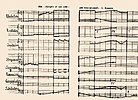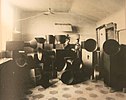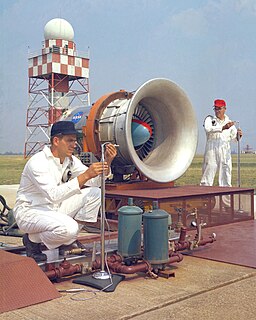
Noise is unwanted sound considered unpleasant, loud or disruptive to hearing. From a physics standpoint, there is no distinction between noise and desired sound, as both are vibrations through a medium, such as air or water. The difference arises when the brain receives and perceives a sound.

Orchestration is the study or practice of writing music for an orchestra or of adapting music composed for another medium for an orchestra. Also called "instrumentation", orchestration is the assignment of different instruments to play the different parts of a musical work. For example, a work for solo piano could be adapted and orchestrated so that an orchestra could perform the piece, or a concert band piece could be orchestrated for a symphony orchestra.
Noise music is a genre of music that is characterised by the expressive use of noise within a musical context. This type of music tends to challenge the distinction that is made in conventional musical practices between musical and non-musical sound. Noise music includes a wide range of musical styles and sound-based creative practices that feature noise as a primary aspect.
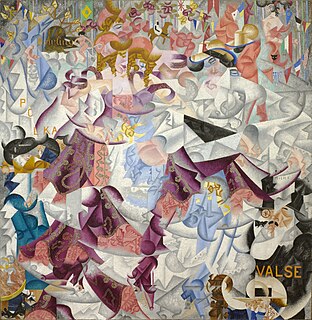
Futurism was an artistic and social movement that originated in Italy in the early 20th century and to a lesser extent in other countries. It emphasized dynamism, speed, technology, youth, violence, and objects such as the car, the airplane, and the industrial city. Its key figures included the Italians Filippo Tommaso Marinetti, Umberto Boccioni, Carlo Carrà, Fortunato Depero, Gino Severini, Giacomo Balla, and Luigi Russolo. Italian Futurism glorified modernity and according to its doctrine, aimed to liberate Italy from the weight of its past. Important Futurist works included Marinetti's 1909 Manifesto of Futurism, Boccioni's 1913 sculpture Unique Forms of Continuity in Space, Balla's 1913–1914 painting Abstract Speed + Sound, and Russolo's The Art of Noises (1913).
Glitch is a genre of electronic music that emerged in the 1990s. It has been described as having an "aesthetic of failure" distinguished by the deliberate use of glitch-based audio media and other sonic artifacts.
20th-century classical music describes art music that was written nominally from 1901 to 2000, inclusive. Musical style diverged during the 20th century as it never had previously. So this century was without a dominant style. Modernism, impressionism, and post-romanticism can all be traced to the decades before the turn of the 20th century, but can be included because they evolved beyond the musical boundaries of the 19th-century styles that were part of the earlier common practice period. Neoclassicism and expressionism came mostly after 1900. Minimalism started much later in the century and can be seen as a change from the modern to post-modern era, although some date post-modernism from as early as about 1930. Aleatory, atonality, serialism, musique concrète, electronic music, and concept music were all developed during the century. Jazz and ethnic folk music became important influences on many composers during this century.
Ellen Fullman is an American composer, instrument builder, and performer. She was born in Memphis, Tennessee, and is currently based in the San Francisco Bay Area. She is known for her 70-foot (21-meter) Long String instrument, tuned in just intonation and played with rosin-coated fingers.

Giacomo Balla was an Italian painter, art teacher and poet best known as a key proponent of Futurism. In his paintings he depicted light, movement and speed. He was concerned with expressing movement in his works, but unlike other leading futurists he was not interested in machines or violence with his works tending towards the witty and whimsical.

Luigi Carlo Filippo Russolo was an Italian Futurist painter, composer, builder of experimental musical instruments, and the author of the manifesto The Art of Noises (1913). He is often regarded as one of the first noise music experimental composers with his performances of noise music concerts in 1913–14 and then again after World War I, notably in Paris in 1921. He designed and constructed a number of noise-generating devices called Intonarumori.
Antonio Russolo (1877–1943) was an Italian Futurist composer and the brother of the more famous Futurist painter, composer and theorist Luigi Russolo. He is noted for composing pieces made with the intonarumori and, together with his brother, introduced The Art of Noises.
Franco Casavola was a Futurist composer and theorist. He is noted as one of the authors of the Le Sintesi Visive della Musica, a manifesto that proposed the intrinsic visual counterparts of music.

Francesco Balilla Pratella was an Italian composer, musicologist and essayist. One of the leading advocates of Futurism in Italian music, much of Pratella's own music betrays little obvious connection to the views espoused in the manifestos he authored.
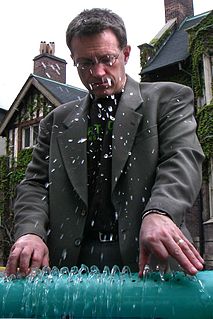
An experimental musical instrument is a musical instrument that modifies or extends an existing instrument or class of instruments, or defines or creates a new class of instrument. Some are created through simple modifications, such as cracked drum cymbals or metal objects inserted between piano strings in a prepared piano. Some experimental instruments are created from household items like a homemade mute for brass instruments such as bathtub plugs. Other experimental instruments are created from electronic spare parts, or by mixing acoustic instruments with electric components.

Luciano Chessa is a musician, performance/visual/installation artist, and musicologist.

Futurism was an early 20th-century art movement which encompassed painting, sculpture, poetry, theatre, music, architecture, cinema and gastronomy. Filippo Tommaso Marinetti initiated the movement with his Manifesto of Futurism, published in February 1909. Futurist music rejected tradition and introduced experimental sounds inspired by machinery, and influenced several 20th-century composers. According to Rodney Payton, “early in the movement, the term ‘Futurism’ was misused to loosely define any sort of avant-garde effort; in English, the term was used to label a composer whose music was considered ‘difficult.’”
The year 2009 in art involves various significant events.
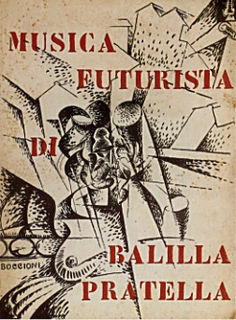
The Manifesto of Futurist Musicians is a manifesto written by Francesco Balilla Pratella on October 11, 1910. It was one of the earliest signs of Futurism's influence in fields outside of the visual arts.

Intonarumori are experimental musical instruments invented and built by the Italian futurist Luigi Russolo between roughly 1910 and 1930. There were 27 varieties of intonarumori built in total, with different names.

Ugo Piatti was an Italian painter and instrument maker, best known for collaborating on the construction of the intonarumori with Luigi Russolo.

In music, noise is variously described as unpitched, indeterminate, uncontrolled, loud, unmusical, or unwanted sound. Noise is an important component of the sound of the human voice and all musical instruments, particularly in unpitched percussion instruments and electric guitars. Electronic instruments create various colours of noise. Traditional uses of noise are unrestricted, using all the frequencies associated with pitch and timbre, such as the white noise component of a drum roll on a snare drum, or the transients present in the prefix of the sounds of some organ pipes.





